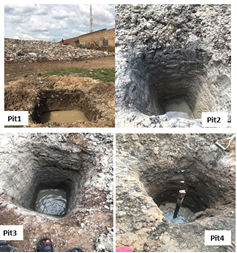Assessing leachate contamination and groundwater vulnerability in urban dumpsites: a case study of the Ipata Area, Ilorin, Nigeria
Keywords:
Leachate contamination, Soil classification, Sustainable waste management, Groundwater quality monitoringAbstract
This study explores the extent of leachate contamination and groundwater vulnerability in urban dumpsites, with a specific focus on the Ipata area in Ilorin, Nigeria. The study employs a combination of 2D Electrical Resistivity Tomography (ERT), soil classification, and physicochemical analyses to investigate the percolation of leachate into groundwater and its potential environmental and health implications. The ERT data unveiled subsurface layers, highlighting the presence of decomposed topsoil down to approximately 1.2m. Beneath this layer, a low-resistivity zone (6.53 to 10.7 ?m) indicated the potential risk of leachate percolation into groundwater. Soil classification revealed a shallow topsoil layer with insufficient clay content to hinder leachate penetration, emphasizing the need for enhanced containment measures. Physicochemical analysis of leachate, well water, and soil displayed variations in key parameters such as pH, electrical conductivity, total dissolved solids, and anion concentrations. Leachate exhibited high pH and electrical conductivity, suggesting elevated total dissolved solids, while well water remained within acceptable pH limits for drinking water. Heavy metal concentrations exceeded permissible WHO limits in topsoil, leachate, and well water, with cadmium presenting a high ecological risk. The absence of persistent organic pollutants (POPs) in the samples indicates a current focus on heavy metals as a primary concern. In conclusion, this study underscores the urgent need for proactive pollution abatement measures in urban dumpsites like Ipata. Regular monitoring of surface and groundwater quality is essential to safeguard public health and the environment.

Published
How to Cite
Issue
Section
Copyright (c) 2024 N. K. Olasunkanmi, D. T. Ogundele, V. T. Olayemi, W. A. Yahya, A. R. Olasunkanmi, Z. O. Yusuf, S. A. Aderoju

This work is licensed under a Creative Commons Attribution 4.0 International License.





